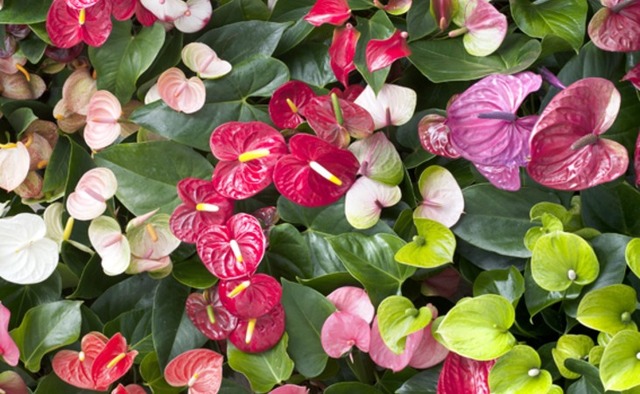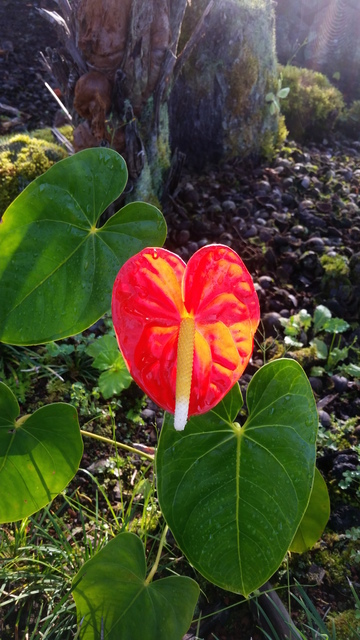Anthirums provide colorful flowers for the wet season
If you have a cool spot in partial shade where the soil has ample organic matter, can be kept moist and has good drainage, consider planting some anthuriums for a splash of color in your summer garden. The cut flowers of these colorful plants can last for weeks and bring their bright beauty into your house as well.
Anthurium is a very large genus with over 1,000 species which is about one third of their Araceae or Aroid family. Many in this family are often found in Hawaiian gardens. Of course, the native taro or kalo plant is one of the best known family members with an edible root that is a Hawaiian staple. Ornamentals that are often grown here including caladium, dieffenbachia, monstera, philodendron, spathiphyllum and syngonium are also close cousins to anthuriums.
The colorful anthurium is a perennial herbaceous plant whose cultivars are mostly derived from the wild Anthurium andreanum that is native to the Pacific coast of Columbia and Ecuador. Crosses with several other varieties have produced a hybrid that is used as the basis for developing new colors, sizes and textures as well as disease resistance. Many nurseries here on the Big Island grow and ship anthurium flowers and several have horticulturists working on new cultivars.
The beauty of the anthurium centers on the colorful bract or spathe of the plant. The sexual part of the plant (the flower) is tiny and insignificant and is arranged along the spadix or spike that emerges from the spathe. When pollinated, these flowers develop into small fruit or berries that contain a seed or two. These seeds can be used to grow new plants. Seedlings may take a few years to mature and flower, however. Faster maturation is achieved by taking cuttings or doing root division. Micro-propagation of anthuriums is often conducted in labs to produce the large quantities required to fill the worldwide demand for this popular ornamental.
The original A.andreanum was brought to Hawaii from England by Samuel Damon in 1889. Damon brought a white, a pink and a red variety and soon began creating new cultivars. Through selective breeding, we now have anthuriums in green, yellow, orange, purple and even black. Variegated colored spathes have also been developed. Spathes now range in size from under three inches to more than eight inches across.
Anthurium cultivars are broadly classified into three types: standard, tulip and obake. The standards have broad, open spathes or bracts and are usually in a single color. The tulip types have a narrow, upright bract with a similarly straight and upright spadix. The third type, Obake anthuriums are highly prized. Their name is a Japanese word that translates as “a thing that changes” or “a ghost.” They usually have large bracts that often have several colors and some are quite pale in appearance, thus the name. Obake often have some green in their coloration. The color may vary from flower to flower, however, and change as the plant ages.
Like many other plants in the Aroid family, anthuriums have lovely heart shaped leaves. On some cultivars, the young leaves are soft and red but most mature to a leathery dark green. A 24 page free publication from University of Hawaii, Anthurium Culture in Hawaii, is available at https://www.ctahr.hawaii.edu/oc/freepubs/pdf/RES-152.pdf. It includes more information on anthurium cultivars and cultivation. The publication also includes propagation tips for growing from seed, cuttings and tissue culture. Those grown from seed or in a lab can take up to three years to flower. Propagation by dividing the roots or removing the top of an older plant as a cutting is the quickest way to get a new flowering plant.
Healthy anthuriums need little care. If properly placed, kept in a humid environment, adequately watered and fertilized regularly they will not attract insects like thrips or whitefly or get diseases like anthracnose or anthurium blight. Check online or in the CTAHR publication for control of these issues if they appear.
Several local nurseries have anthuriums in a variety of types and colors. Sunrise Nursery has many and gets new ones regularly. Call 329-7593 to see what they have in stock. Future Forests Nursery has several tropical ornamentals including anthuriums in stock. Check at www.futureforestsnursery.com for prices and call for more information.
With our rainy season upon us, now is the time to consider moisture-loving plants like anthurium to enhance our gardens and provide a summer supply of cut flowers.
Diana Duff is a plant adviser, educator and consultant living on an organic farm in Captain Cook.
Gardening Events
Saturday: “Work Day at Amy Greenwell Garden” from 9 a.m.to 12:30 p.m. Meet at the Garden Visitor Center across from the Manago Hotel in Captain Cook. Volunteers will be able to help with garden clean up and are invited to bring a brown bag lunch. Water and light refreshments offered. Call Peter at 323-3318 for more information.
Farmer Direct Markets
Wednesday: “Hooulu Farmers Market” 9 a.m. to 2 p.m. at the Sheraton Kona Resort &Spa at Keauhou Bay
Wednesday: “Sunset Farmers Market” 2 p.m. – sunset at the north makai corner of the Kmart parking lot.
Saturday: “Keauhou Farmers Market” 8 a.m. – noon at Keauhou Shopping Center
“Kamuela Farmer’s Market” from 7 a.m. to noon at Pukalani Stables
Sunday: “South Kona Green Market” 9 a.m. – 2 p.m. at Amy Greenwell Garden in Captain Cook
Monday–Saturday: “U-Pick greens and produce” 10 a.m.to 4 p.m. Tropical Edibles Nursery, Captain Cook.
Plant Advice Lines
Anytime: konamg@ctahr.hawaii.edu
Tuesday &Thursday: 9 a.m. to noon at UH-CES in Kainaliu – 322-4892
Monday, Tuesday and Friday: 9 a.m. to noon at UH CES at Komohana in Hilo 981-5199 or himga@hawaii.edu




